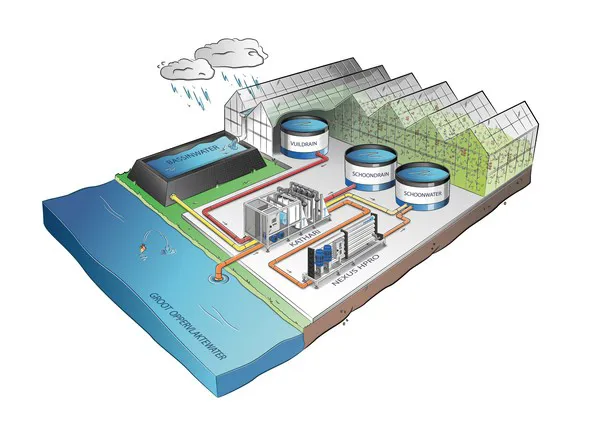Good horticultural irrigation water availability is becoming an ever-growing global issue. Worldwide, climate change plays a significant role in this. In Europe, it is shrinking groundwater levels. In the Netherlands, research is already underway at industry level. People are trying to find alternative sustainable irrigation water sources. Growers looking for solutions can contact Van der Ende Groep.
Not so long ago, farmers could rely on the Dutch rain. Once purified, you can use rainwater as a primary irrigation source. Things have clearly been changing since the turn of the century. Drought periods - at least 20 consecutive days without measurable precipitation - are more common. The years 2018 and 2020 have been the driest in the Netherlands' recorded history.
 The Van der Ende Groep's Kathari treats water in three different situations.
The Van der Ende Groep's Kathari treats water in three different situations.
This year has begun with little rainfall and rising temperatures. In 2018, it was dry from July until fall. That is according to the Dutch weather forecasting service. It usually rains proverbial buckets then. Similar amounts of rain may fall over the course of a year. However, input water availability is compromised.
Alternative greenhouse cultivation water sources
Growers want a high recovery rate and are looking for alternative water sources. These are available, but always with advantages and disadvantages. Wellwater is a common alternative. There are also water companies that improve surface water's quality. In other areas, rivers and other surface water are 'clean' enough to be used as input water. More and more, greenhouse farming water is coming from industry or even power plants.
Highly efficient, reverse osmosis water treatment
There are, therefore, alternatives. However, none can be used directly for crop irrigation. As a minimum, you need to treat it using reverse osmosis. The Van der Ende Group has developed the Nexus High-Performance RO (HPRO) for this, which growers can use to remove ballast substances like salts.
This 'flavors' the water, which is then almost completely stripped of unwanted elements. This system has a crucial advantage - unmatched efficiency. A plus that is even more important in times of high energy costs. The Nexus HPRO has an up-to-95% recovery rate. So, it scores top points concerning price-performance ratio per cubic meter.
Ultrafiltration
Using reverse osmosis can, therefore, result in good irrigation water. The Van der Ende Groep has developed the Kathari for this. This ultrafiltration system efficiently recirculates that water. It has a high degree of virus, bacterium, and fungal removal. And it is efficient, cost-wise, due to low operational and investment costs. Sometimes, water is also wasted because of its excessive sodium content. You can use a sodium remover to avoid this. Using different water strategies ensures irrigation water supply continuity.
For more information:
Van der Ende Groep
Email: sales@vanderendegroep.nl
Website: www.vanderendegroep.nl
